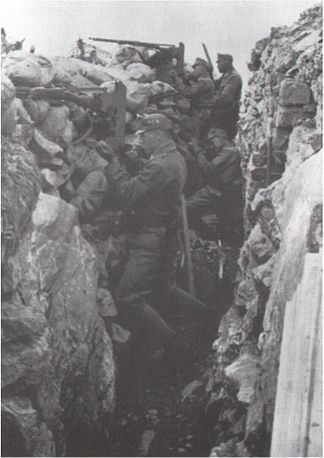

The Italian defensive trenches in front of Čiginj (Cighino) were overrun on 24 October, and their strongholds in Ježa (Monte Jeza) had been destroyed by nightfall the same day. Kobarid (Caporetto) was taken on the same day, and they reached the national border south of Robič (Robis) in the early hours of 25 October.

The 14th Army infantry penetrated the Italian positions at Bovec (Plezzo), in the Isonzo valley, and Tolmin (Tolmino). On 24 October at 2am, the Austrian-Hungarian-German opened a massive artillery barrage at Rombon and used fosgen poison gas near Bovec (Plezzo). The 10th Austrian-Hungarian Army was also to participate. The 1st and 2nd Isonzo Armies, which were already positioned along the river, were joined by twelve divisions of the 14th joint German-Austrian Army. The new offensive was called Waffentreue (“loyalty in arms”) and was planned by the German General Kraft von Dellmensingen. They asked their German allies for help, the preparations for a joint Austian-Hungarian-German offensive commenced during the 11th Battle of the Isonzo.
BATTLE OF ISONZO FULL
The 173rd is the Army Contingency Response Force in Europe, and is capable of projecting forces to conduct the full of range of military operations across the United States, European, Central and Africa Commands areas of responsibility.The defenders of the Isonzo Front were aware they would not be able to hold back another Italian attack. It also gave me the opportunity to interact with other nations so that we can continue to strengthen the bond we’ve established here.” “This trip has given me the opportunity to learn more about our partner forces and what they experienced during that time period. Desireé Genus, the brigade’s knowledge manager for the exercise. “Today was an eye opening experience,” said U.S. Lessons from war provide the opportunity for each nation to strengthen their respective forces and bond for a common cause. Paratroopers from the 173rd Airborne represent the bulk of U.S. “But it seems like very harsh and unforgiving fighting conditions they were under.” First Class Tony Horseman, the 173rd’s brigade medical operations non-commissioned officer. “I think today’s visit was really interesting and visually spectacular,” said U.S. The area has been kept intact with original structures still in place. The ridge of Kolovrat is a transitory area between the upper Soca region in Slovenia and the Veneto region in Italy where the 1915-1917 Battle of Isonzo was fought, said Torkar. But more importantly, he says, they can learn about cohesion, trust and morale. It provides soldiers the opportunity to learn about different tactics, mission command and logistics. During the visit to Kobarid, military historians discussed the obstacles that Soldiers went through during the First World War and how we can learn from the struggles and triumphs of that past.įor military personnel this is a place of education, stated Blaz Torkar, a Slovenian military historian with Military Schools Center. This year, there are over 450 participants in the exercise. The exercise also improves North Atlantic Treaty Organization interoperability between U.S. Immediate Response 14 is an exercise designed to deploy multinational forces in response to a disaster relief mission. KOBARID, Slovenia – A multinational team of paratroopers of the 173rd Airborne Brigade and allies from European nations conducted a walking tour of Kolovrat Outdoor Museum of the First World War in Soca Valley Region as part of cultural day for combined exercise Immediate Response 14 on Aug.


 0 kommentar(er)
0 kommentar(er)
